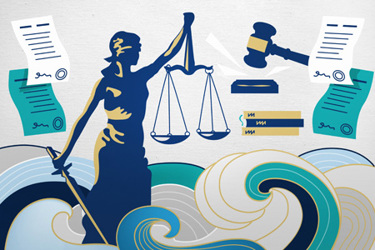CERCLA And PFAS: What's The Liability For Water And Wastewater Utilities?
By Ken Sansone

Federal rules aim to target those liable but may miss the mark. Utilities can redirect the effort — and costs — to those truly responsible for PFAS contamination.
Effective for nearly a year, the designation of two common per- and polyfluoroalkyl substances (PFAS) as hazardous substances under the Comprehensive Environmental Response, Compensation, and Liability Act (CERCLA) stands to impact public works operations such as water and wastewater treatment facilities, municipal landfills, and airports. Also known as Superfund, CERCLA was enacted in 1980 to protect public health, clean water, and the environment by mandating remediation of environmental contaminants.
CERCLA authorizes the U.S. EPA to identify and investigate site contamination, order site cleanups, recover cleanup costs from potentially responsible parties, and require responsible parties to report releases into the environment. For pollution involving the two specific PFAS named in the June 2024 designation — PFOS and PFOA — this regulation creates Superfund liability for owners and operators of sites where there have been releases of these substances, exposing those agencies to the risk of citizen cost recovery suits for any environmental impacts.
When a contaminant is designated as a CERCLA hazardous substance, it creates liabilities and responsibilities for entities that — either actively or passively — release such contaminants into the environment. This creates troubling implications especially for public agencies, which could be held responsible for the high costs of remediation of a contaminant that they neither manufactured nor introduced. Even more concerning, CERCLA liability is retroactive; therefore, entities can be held liable for PFAS released into the environment years or even decades ago. Since PFAS (“forever chemicals”) persist in the environment for extensive periods of time, agencies could be forced to remediate sites affected by long-ago contamination.
CERCLA claims against water and wastewater utilities historically have been rare, but because of the scope of PFAS contamination in both drinking water supplies and wastewater streams, there’s reason for concern. The cost and impact of PFAS contamination and its remediation expense could rival that of asbestos and lead.
Highlighting concerns about liability, procedural fairness, and the potential economic impacts on various industries, several industry groups have initiated legal challenges against the EPA regarding the CERCLA designation. In February 2025, the U.S. Court of Appeals for the District of Columbia Circuit granted the U.S. EPA’s request for a 60-day stay that pauses this litigation, which would give the EPA and its new leadership time to reassess its approach to PFAS regulation.
The Water Systems PFAS Liability Protection Act
At the time of the designation, the EPA announced a “PFAS Enforcement Discretion and Settlement Policy,” indicating it will likely not bring CERCLA actions against passive receivers like municipal water and wastewater facilities but rather focus on industrial PFAS discharge. However, even this EPA policy, which is discretionary and not guaranteed, does not exempt public agencies from lawsuits filed by other parties like private citizens or state governments.
To more formally protect public entities from PFAS liability, members of the U.S. House of Representatives introduced the Water Systems PFAS Liability Protection Act in 2024 as H.R.7944. It aims to exempt certain entities, such as water and wastewater treatment facilities, from CERCLA liability with specific regard to PFAS contamination, with the goal that polluters, not taxpayers, shoulder the burden of cleanup costs. This act provides that agencies will be protected from CERCLA liability as long as they’re in compliance with “all applicable laws at the time the activity is carried out.” Violations of state law requirements or permit conditions would arguably forfeit this immunity — as would acting with “gross negligence or willful misconduct.”
This bill did not advance out of committee review before the end of the 2024 legislative session, but in February of this year, the bipartisan bill was reintroduced as H.R.1267 and is currently under consideration by the House Committees on Energy and Commerce, and Transportation and Infrastructure.
Multiple trade groups that represent public works organizations have expressed support for this bill, including the American Water Works Association (AWWA), National Association of Clean Water Agencies (NACWA), National Rural Water Association (NRWA), American Public Power Association (APPA), and the Water Environment Federation (WEF). There is some concern, however, that this legislation may embolden polluters, who could indirectly benefit from the overall reduction in PFAS lawsuits and the power of litigation to hold responsible parties accountable.
How PFAS Contamination Is Creating Expenses For Water And Wastewater Utilities
Drinking water utilities are currently working toward a June 2029 deadline for complying with Maximum Contaminant Levels (MCLs) finalized by the EPA last year, which target six specific PFAS compounds. These compliance actions are generating significant expenses for utilities, including those related to testing, monitoring, treating, and communicating with the public. And while the CERCLA designation is separate from the drinking water MCLs, water treatment plants could experience repercussions from CERCLA. With a “hazardous substance” designation in place for PFAS, water treatment plants might have to dispose of PFAS-laden spent filtration media differently and with greater expenses. Also, should a water treatment plant detect elevated levels of PFAS in its water source, the site could be added to the National Priorities List (NPL), triggering federal oversight and potential cleanup responsibilities and operational impact.
With regard to affected wastewater treatment plants (as well as municipal landfills and airports), the costs could be even more direct. These facilities are caught in the middle — unable to stop receiving PFAS from various waste streams but required to limit releases without additional funding. The EPA’s designation of PFOA and PFOS as hazardous substances requires wastewater systems to report non-exempt releases of one pound or more within a 24-hour period. Also, utilities that suspect their wastewater effluent or biosolids contain PFAS may be obligated to conduct additional monitoring for releases. Even wastewater systems with releases below the reporting threshold may have liability risk from third-party lawsuits that accuse them of contributing to other agencies’ PFAS cleanup costs.
Many wastewater utilities are already experiencing financial impacts caused by PFAS. In recent decades, biosolids have become a revenue stream for wastewater treatment plants. But in some states, PFAS-laden biosolids are being banned from land application due to PFAS contamination concerns, a turn that is both decreasing revenue and increasing disposal costs for wastewater treatment plants.
Utilities Are Using The Law To Ensure Funding
To proactively plan, many utilities are using the law to hold polluters responsible, so that neither the utilities nor the ratepayers are left holding the bag for contamination they did not cause. Utilities can recover significant costs related to PFAS cleanup by bringing legal claims against the PFAS manufacturers that caused the contamination in the first place. Without settlements or awards from these manufacturers, utilities will have to absorb the treatment costs on their own. These can run into the many millions of dollars for almost any utility operating in a state with restrictions on PFAS concentrations in its water, effluent, or sludge.
Affected utilities, states, property owners, and other entities have filed lawsuits to hold the PFAS manufacturers accountable, with many cases consolidated into the Aqueous Film-Forming Foam (AFFF) MDL (multidistrict litigation), which coordinates similar cases filed in multiple federal district courts to streamline the legal process. So far, the AFFF MDL has been an effective cost-recovery strategy for participating drinking water systems — nearly $15 billion in settlements have been obtained from large-scale PFAS manufacturers 3M, DuPont, BASF, and Tyco for impacts to public drinking water supplies. The current settlements only apply to drinking water providers, but they illustrate the potential for significant cost recovery through litigation and serve as a valuable funding strategy tool for PFAS-impacted communities.
About The Author
 Ken Sansone is a partner at SL Environmental Law Group PC, where he represents water suppliers and other public agencies in contamination lawsuits, including claims over PFAS, 1,2,3-trichloropropane (TCP), and perchlorate. Prior to joining SL, Sansone was an assistant attorney general for New Hampshire. He has more than 20 years of experience handling complex civil and criminal cases in federal and state trial and appellate courts. He received his law degree from New York University and his undergraduate degree, magna cum laude, from Duke University.
Ken Sansone is a partner at SL Environmental Law Group PC, where he represents water suppliers and other public agencies in contamination lawsuits, including claims over PFAS, 1,2,3-trichloropropane (TCP), and perchlorate. Prior to joining SL, Sansone was an assistant attorney general for New Hampshire. He has more than 20 years of experience handling complex civil and criminal cases in federal and state trial and appellate courts. He received his law degree from New York University and his undergraduate degree, magna cum laude, from Duke University.
